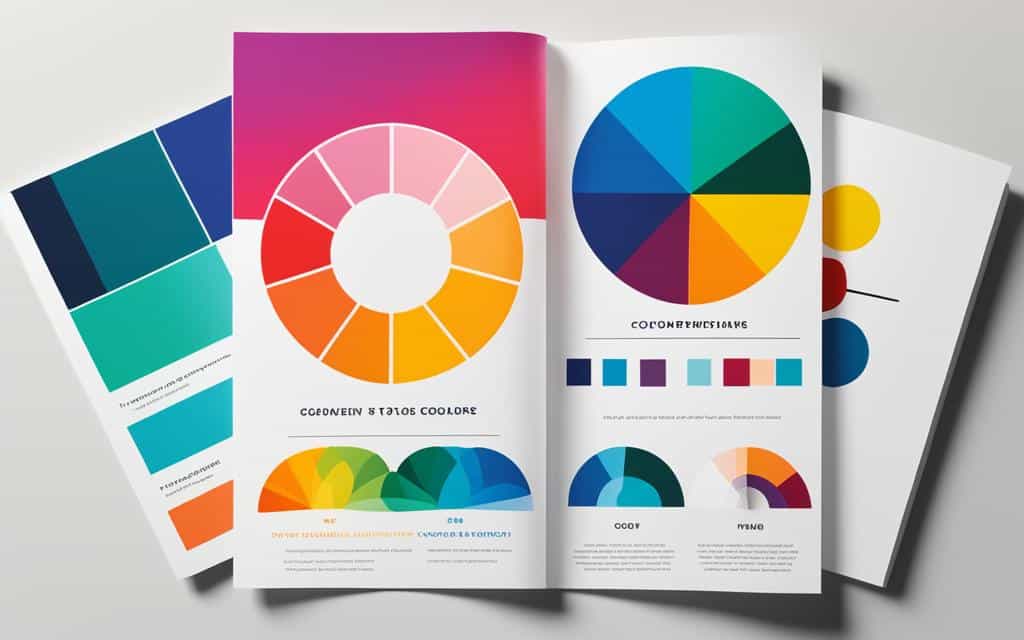Table of Contents
Color theory is a fundamental aspect of design, particularly in style guides, branding, and visual communication. Understanding color theory empowers designers to make informed choices, create visually appealing designs, and effectively communicate brand messages. By considering factors like color harmony, color palettes, and audience preferences, designers can maximize the impact of their designs and create engaging user experiences. The knowledge of color theory helps businesses stand out from the crowd, evoke desired emotions, and establish a strong brand identity.
Colors have the power to evoke emotions, convey messages, and create visual contrast. Research shows that people make subconscious judgments about products based on color alone. That’s why effective color use is crucial in creating style guides that visually communicate a brand’s identity and message.
Color theory serves as a framework for designers to curate color palettes and achieve aesthetic and psychological effects. With a solid understanding of color theory, designers can choose the right combinations, create harmonious designs, and establish brand consistency across various design elements.
In the following sections, we will explore the key concepts of color theory, the importance of color harmony, different color models, the role of color palettes, and how to choose the best color combinations for your brand’s style guide.
What is Color Theory?
Color theory is a fundamental framework that guides the use of color in art and design. It plays a crucial role in curating effective color palettes and effectively communicating design messages on aesthetic and psychological levels.
The foundation of modern color theory can be traced back to Isaac Newton’s color wheel, developed in 1666. This color wheel categorizes colors into primary, secondary, and tertiary colors, providing a systematic approach to understanding and working with color.
Within the realm of color theory, there are various color variants that designers need to understand to create bespoke color palettes that promote aesthetic harmony. These variants include hues, shades, tints, and tones.
Understanding color theory is essential for designers in art and design disciplines, as it enables them to harness the power of color and make informed decisions when creating visually appealing designs. By applying color theory principles, designers can effectively communicate brand messages and create engaging user experiences.
| Color Theory Principles | Benefits |
|---|---|
| Guides the use of color in art and design | Creates visually appealing designs |
| Facilitates curating effective color palettes | Effectively communicates design messages |
| Enables understanding of color variants | Promotes aesthetic harmony |
The Importance of Color Harmony
Color harmony plays a crucial role in achieving visually pleasing designs, especially in UI design. It involves the thoughtful selection and combination of colors that are pleasing to the human eye. Whether promoting contrast or consonance, the goal is to create a visually satisfying effect that engages viewers and establishes a sense of balance and order in the interface.
When designing a user interface, color harmony should never be overlooked. Without it, an interface can become under-stimulating, causing users to lose interest and engagement. On the other hand, over-stimulating interfaces can overwhelm users and hinder their ability to focus on important elements.
To achieve color harmony, it is important to consider the contrast between colors and ensure they work together cohesively. This can be achieved through various techniques, such as using complementary colors or selecting colors from the same color family. By creating a balanced color palette, designers can evoke the desired emotional response from users and enhance the overall experience.
The human eye naturally seeks out contrast and variation, making it important to incorporate these elements into color design. Contrast helps draw attention to specific elements and improves readability, while consonance creates a sense of unity and cohesion. Striking the right balance between contrast and consonance is essential to achieving color harmony and creating visually pleasing designs.
Here is an example of how color harmony can be applied in UI design:
| Color Palette | Description |
|---|---|
| Primary Color: #FF5733 | The vibrant primary color serves as the focal point, drawing attention to important elements. |
| Secondary Color: #334BFF | The secondary color provides contrast and visual interest when combined with the primary color. |
| Tertiary Color: #33FFB2 | The tertiary color adds a complementary touch to the palette, creating harmony and depth. |
| Accent Color: #FFD433 | The accent color is used sparingly to highlight specific elements or interactive elements. |
By carefully selecting and combining colors that harmonize well, designers can create visually appealing interfaces that capture users’ attention and enhance their experience. Color harmony is a powerful tool in UI design and should be prioritized to create stunning and engaging interfaces.
Additive and Subtractive Color Models
Understanding color models is essential for designers to effectively work with different mediums and ensure accurate color representation. There are two primary color models: additive and subtractive.
The additive color model is based on light waves and is commonly used in electronic screens. It is represented by the RGB color model, which stands for red, green, and blue. In this model, colors are created by adding different intensities of red, green, and blue light. The more color is added, the closer it gets to white. This model is used in various electronic devices, such as televisions, computer monitors, and mobile screens. It allows for vibrant displays and a wide range of colors to be produced.
The subtractive color model, on the other hand, is based on the subtraction of light and is primarily used in physical printing. It is represented by the CMYK color model, which stands for cyan, magenta, yellow, and black. In this model, color is created by subtracting varying amounts of these ink colors from white or light-colored paper. The more color is subtracted, the closer it gets to black. The CMYK color model is used in printers and other physical printing processes to reproduce colors in printed materials, such as brochures, magazines, and packaging.
Both the additive and subtractive color models have their unique characteristics and applications. Designers need to be familiar with these models to ensure that the colors they choose are accurately represented in different mediums, whether it’s on electronic screens or through physical printing.
Comparison of Additive and Subtractive Color Models
| Color Model | Representation | Color Creation | Applications |
|---|---|---|---|
| Additive | RGB (Red, Green, Blue) | Colors are created by adding red, green, and blue light | Electronic screens: televisions, computer monitors, mobile screens |
| Subtractive | CMYK (Cyan, Magenta, Yellow, Black) | Colors are created by subtracting cyan, magenta, yellow, and black inks from white or light-colored paper | Physical printing: brochures, magazines, packaging |
Introduction to Color Palettes
Color palettes play a crucial role in UI design, serving as the building blocks for creating visually compelling interfaces. They are the combination of colors carefully selected and used by UI designers to enhance the visual foundation of a brand and ensure consistency across different design elements. By understanding color theory and considering factors such as color harmony, brand identity, and user experience, UI designers can create aesthetically pleasing and engaging user interfaces that align with the brand’s objectives.
There are various tools and technologies available to create color palettes, allowing designers to explore different combinations and options. The appropriate choice of a color palette contributes to the overall aesthetic harmony of the design and helps establish brand consistency.
Types of Color Palettes
UI designers have the flexibility to choose from different types of color palettes based on their specific design requirements. These palettes offer a range of color combinations that can evoke different emotions and create different visual effects. Some commonly used color palettes include:
- Monochromatic: Consists of different shades, tints, or tones of a single color, providing a clean and cohesive look.
- Analogous: Combines colors that are adjacent to each other on the color wheel, creating a harmonious and balanced composition.
- Complementary: Combines colors that are opposite each other on the color wheel, providing a high contrast and vibrant visual impact.
- Split-Complementary: Uses a base color and two colors adjacent to its complement, offering a balanced yet vibrant color combination.
- Triadic: Combines three equally spaced colors on the color wheel, providing a dynamic and energetic color scheme.
- Tetradic: Uses two sets of complementary colors, offering a diverse and contrasting combination.
Each type of color palette brings its own unique visual appeal and can be tailored to suit the brand’s identity and target audience. These versatile options allow UI designers to create captivating interfaces that align with the brand’s aesthetic vision.
| Type of Color Palette | Description |
|---|---|
| Monochromatic | Consists of different shades, tints, or tones of a single color, providing a clean and cohesive look. |
| Analogous | Combines colors that are adjacent to each other on the color wheel, creating a harmonious and balanced composition. |
| Complementary | Combines colors that are opposite each other on the color wheel, providing a high contrast and vibrant visual impact. |
| Split-Complementary | Uses a base color and two colors adjacent to its complement, offering a balanced yet vibrant color combination. |
| Triadic | Combines three equally spaced colors on the color wheel, providing a dynamic and energetic color scheme. |
| Tetradic | Uses two sets of complementary colors, offering a diverse and contrasting combination. |
How to Choose a Color Palette
When it comes to choosing a color palette for a user interface, there are several factors that need to be taken into consideration. By carefully considering these factors, designers can create a color scheme that effectively communicates the desired message and resonates with the target audience. Let’s explore some key considerations for selecting the perfect color palette.
- Research Audience: It’s crucial to understand the target audience and their preferences when selecting a color palette. Emotional responses to colors can vary based on personal factors, including cultural background. Conducting research and gathering insights about the target audience will help identify the colors that align with their preferences and resonate with them on an emotional level.
- Consistency: Consistency is key in establishing a recognizable brand identity. It’s important to use consistent colors across branding materials to create a cohesive visual representation of the brand. Consistency in color usage helps consumers easily identify and associate the brand with specific colors, enhancing brand recall and recognition.
- Mood Board: Creating a mood board can be a helpful step in the color palette selection process. A mood board is a visual representation that includes color swatches, images, and inspirations that capture the desired aesthetic and mood of the brand or project. It serves as a guiding reference in choosing the right colors that align with the intended visual style.
- Contrast: Effective use of contrast is crucial in creating visually engaging designs. Contrast between different elements of the user interface, such as text and background, helps enhance readability and visual interest. When selecting a color palette, consider the level of contrast between different colors to ensure that the interface is visually impactful and easy to navigate.
- Exploring Different Harmonies: Color harmonies play a significant role in creating a visually pleasing composition. By exploring different color harmonies, such as complementary, analogous, and triadic, designers can experiment with various color combinations and find the ones that best represent the brand and evoke the desired emotions.
- Audience Testing: Once a color palette is selected, it’s important to test it with the target audience to ensure its effectiveness. Feedback from the audience can provide valuable insights on how the chosen colors are perceived and whether they effectively communicate the desired message. This iterative process helps refine the color palette and ensure its suitability for the specific brand and target audience.
Choosing the right color palette for a user interface requires careful consideration of various factors, including the target audience, emotional responses, cultural factors, consistency, mood boards, contrast, and audience testing. By following these guidelines and conducting thorough research, designers can create visually captivating designs that resonate with the intended audience and effectively communicate the brand’s message.
Conclusion
Color theory plays a fundamental role in design, specifically in style guides, branding, and visual communication. The understanding of color theory empowers designers to make well-informed decisions, create visually appealing designs, and effectively convey brand messages. By considering elements such as color harmony, color palettes, and audience preferences, designers can maximize the impact of their designs and deliver engaging user experiences. The knowledge of color theory enables businesses to differentiate themselves, evoke the desired emotions, and establish a strong brand identity.
Effective color use is a key factor in creating memorable designs and captivating visual experiences. When applied thoughtfully, colors have the power to evoke specific emotions, influence perceptions, and leave a lasting impression on the audience. By leveraging color theory principles, designers can select harmonious color combinations that resonate with the brand’s personality and effectively communicate its values. This ensures consistency in visual communication and strengthens the brand’s impact across various touchpoints.
Style guides play an essential role in maintaining brand consistency and providing guidelines for visual communication. By incorporating color theory principles into style guides, designers can establish a solid foundation for the brand’s visual identity. This includes defining color palettes, specifying color usage, and ensuring visual harmony across all brand assets. Style guides that adhere to effective color use and color theory principles enable businesses to create a cohesive and recognizable brand presence, fostering trust and loyalty among audiences.
In conclusion, understanding color theory is indispensable in design. It equips designers with the knowledge and skills to create visually captivating designs, effectively communicate brand messages, and establish a strong brand identity. By harnessing the power of color theory, businesses can elevate their visual communication, engage their target audience, and make a lasting impact in the competitive market.
FAQ
What is color theory and how does it apply to style guides?
Color theory is a framework that guides the use of color in art and design, particularly in style guides for branding and visual communication. It helps designers curate color palettes and effectively communicate design messages on aesthetic and psychological levels.
How does color harmony play a role in design?
Color harmony is an important aspect of color theory, especially in UI design. It refers to the use of color combinations that are visually pleasing to the human eye. Achieving color harmony in design establishes a sense of balance, engages viewers, and creates a sense of order in the interface.
What are the additive and subtractive color models?
The additive color model, represented by RGB (red, green, blue), is based on light waves and is commonly used in electronic screens. The subtractive color model, represented by CMYK (cyan, magenta, yellow, black), is based on the subtraction of light and is mostly used in physical printing.
What are color palettes and how are they used in UI design?
Color palettes are combinations of colors used by UI designers to create visually appealing and engaging user interfaces. They form the visual foundation of a brand and help maintain consistency across different elements of design. Different types of color palettes offer various choices for designers to work with.
How do I choose a color palette for my user interface?
When choosing a color palette, consider factors like researching the target audience to understand their emotional responses to colors based on cultural factors, ensuring consistency in color usage across branding materials, creating a mood board with color swatches and inspirations, and using contrast effectively to enhance readability and visual interest.
Why is color theory important in design and branding?
Understanding color theory empowers designers to make informed choices, create visually appealing designs, and effectively communicate brand messages. It helps businesses stand out, evoke desired emotions, and establish a strong brand identity.













